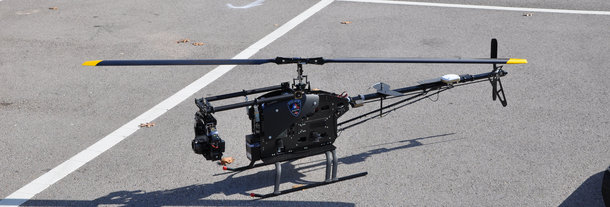Arlington police are testing small unmanned aircraft designed to take high-resolution video and photos of traffic accidents, hostage situations, pursuits of suspects and other emergency situations too dangerous to send personnel.
Data from the testing, which will continue through next January, will help Arlington and law enforcement agencies across the nation evaluate the feasibility and effectiveness of using such remote-controlled surveillance devices for public safety purposes, Police Chief Theron Bowman said.
The aircraft, which look like oversized toy helicopters, can also be equipped with night-vision cameras or thermal-imaging equipment to help officers locate suspects or victims thrown from crash sites. “These devices are literally eyes in the sky to us,” Bowman said. “They have the potential to help law enforcement and the department become more efficient working with just a few people instead of having to employ many people” in certain situations.
For example, Bowman said the aircraft could quickly take hundreds of photographs of a multi-vehicle pileups, allowing a roadway to be opened hours sooner than if an accident investigator was taking pictures from the ground.
The city, working with the Federal Aviation Administration and the U.S. Justice Department, is participating in a national evaluation program. Its data will help develop training and equipment standards for agencies that use the aircraft as crime-fighting tools. Both the Houston and Miami Dade police departments have also tested unmanned aircraft, and other cities have expressed an interest, FAA spokesman Les Dorr said. He added that his agency does not disclose who has applied, citing security and privacy reasons. “Eventually, it’s conceivable police departments could be authorized to conduct operational flights,” Dorr said.
Arlington is leasing one of the devices, an 11-pound, 58-inch electric helicopter known as the Leptron Avenger, which can fly up to 40 mph. The Police Department was also granted two smaller Draganflyer X6 aircraft, and it may lease other remote-controlled devices that can cost $2,500 to $300,000, Bowman said.
During the testing phase, Arlington police must follow numerous regulations. The aircraft can be flown only during daylight hours at no higher than 400 feet and must remain within view of the pilot, who must hold a commercial license and demonstrate the ability to control the device. An observer must also be present.
During flight, the operator must remain in contact with the control tower at Dallas/Fort Worth Airport, and the devices must be able to automatically return to their starting point if they lose communication with the remote control.
“You have to walk before you can fly,” Dorr said. “You have to show you can operate the aircraft effectively without any danger to the people on the ground or other pilots in the air.”
Arlington’s flight area is restricted to secured, city-owned land at the north end of Lake Arlington, but officials are working to expand to other areas by September, Bowman said. Some residents have objected to the plans at City Council meetings, voicing about the possibility of injuries if the vehicles crash into a populated area.
They also are concerned about privacy issues if the department conducts surveillance missions over their homes. Bowman said the department will follow federal, state and local laws when deploying the unmanned aircraft and has no plans to use them for routine surveillance or patrol purposes. “Any use of these vehicles will be restricted to what’s legal and what’s practical, which is the same standard applied to every police action taken today,” Bowman said.
After the test phase, the city plans to seek FAA authorization to deploy the aircraft next year in actual missions, he said.
Source: Star Telegram

